

Insidehighered. The decision last week by the University of California, Berkeley, to take years' worth of video and audio lectures out of the public realm because of federal requirements on accessibility for people with disabilities was decried by many accessibility advocates. And many other universities told Inside Higher Ed this week that they would not be following suit.
Redesigning college processes with the student in mind (essay) Even the most well-intentioned colleges and universities have a hard time figuring out where to start on the path to improving student success and completion.
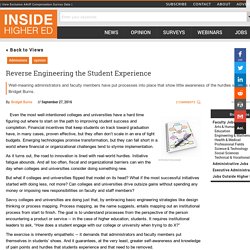
Financial incentives that keep students on track toward graduation have, in many cases, proven effective, but they often don’t scale in an era of tight budgets. Emerging technologies promise transformation, but they can fall short in a world where financial or organizational challenges tend to stymie implementation. As it turns out, the road to innovation is lined with real-world hurdles. Initiative fatigue abounds. And all too often, fiscal and organizational barriers can win the day when colleges and universities consider doing something new. But what if colleges and universities flipped that model on its head? Savvy colleges and universities are doing just that, by embracing basic engineering strategies like design thinking or process mapping. Most higher education institutions can benefit from a similar exercise. 530901. ADA: Fast Facts for Faculty - Teaching Students with Sensory Impairments.
Teaching Students with Sensory Impairments Developed by Patricia Carlton and Jennifer Hertzfeld.
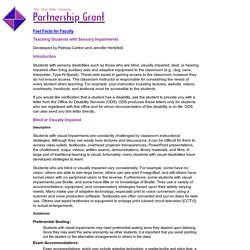
Introduction. Reasonable Accommodations Explained. Reasonable accommodations are modifications or adjustments to the tasks, environment or to the way things are usually done that enable individuals with disabilities to have an equal opportunity to participate in an academic program or a job (U.S.
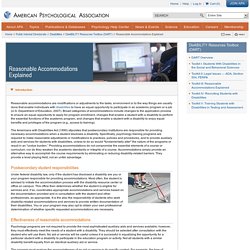
Department of Education, 2007). Broad categories of accommodations include changes to the application process to ensure an equal opportunity to apply for program enrollment, changes that enable a student with a disability to perform the essential functions of the academic program, and changes that enable a student with a disability to enjoy equal benefits and privileges of the program (e.g., access to training).
The Americans with Disabilities Act (1990) stipulates that postsecondary institutions are responsible for providing necessary accommodations when a student discloses a disability. Postsecondary student responsibilities. Berkeley may remove free online content rather than complying with disability law. The University of California, Berkeley, has announced that it may eliminate free online content rather than comply with a U.S.

Justice Department order that it make the content accessible to those with disabilities. The content in question is all free and is for the general public to use. "The department’s findings do not implicate the accessibility of educational opportunities provided to our enrolled students," said a statement on the situation by Cathy Koshland, vice chancellor for undergraduate education. While the university has not made a final decision, she said, it may not be able to afford complying with the Justice Department's recommendations on how to make the online material accessible.
"In many cases the requirements proposed by the department would require the university to implement extremely expensive measures to continue to make these resources available to the public for free," she wrote. Disability Experts Debate Merits of Universal Design - The Chronicle of Higher Education. Berkeley may remove free online content rather than complying with disability law. Untitled. Assisting Students with Disabilities: A Guide for Instructors. Section 504 of the Rehabilitation Act of 1973 states that "no otherwise qualified handicapped individual shall, solely by reason of the handicap, be excluded from the participation in, be denied the benefits of, or be subjected to discrimination under any program or activity receiving federal financial assistance.
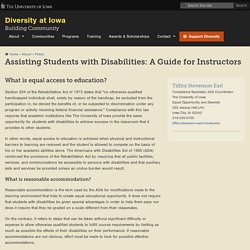
" Compliance with this law requires that academic institutions like The University of Iowa provide the same opportunity for students with disabilities to achieve success in the classroom that it provides to other students. In other words, equal access to education is achieved when physical and instructional barriers to learning are removed and the student is allowed to compete on the basis of his or her academic abilities alone. What is reasonable accommodation? Reasonable accommodation is the term used by the ADA for modifications made to the learning environment that help to create equal educational opportunity. Who qualifies as a disabled individual under the law? YouTube Captioning. This resource is designed to be printed as a one page PDF file.
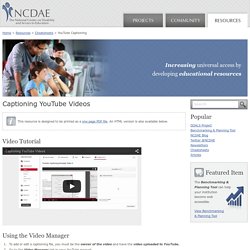
An HTML version is also available below. Video Tutorial Using the Video Manager To add or edit a captioning file, you must be the owner of the video and have the video uploaded to YouTube. Go to the Video Manager tab in your YouTube account. Find the video to caption, and select the Edit button. Using the top navigation bar, click the Subtitles and CC tab. Uploading Caption or Transcript Files to YouTube Videos If a transcript or caption file already exists for a video, simply upload the file to YouTube. ASTwhitepaper HigherEdHandbook 2014 1. Higher Ed Accessibility Lawsuits, Complaints, and Settlements. Higher educational institutions face liability for inaccessible web content and technologies.
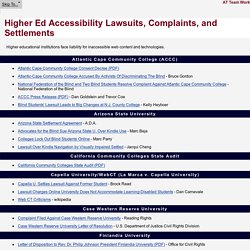
Atlantic Cape Community College (ACCC) Arizona State University California Community Colleges State Audit California Community Colleges State Audit (PDF) Capella University/WebCT (La Marca v. Case Western Reserve University Finlandia University. Closed-Captioning: by Sarah Kiefer on Prezi. The Paciello Group – Your Accessibility Partner (WCAG 2.0/508 audits, VPAT, usability and accessible user experience) This tool provides two useful core functionalities:
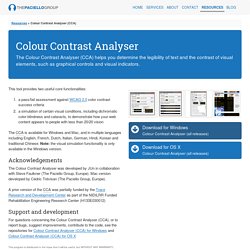
HHS Section 508 Accessibility checklists. More than Mere Transcription: Closed Captioning as an Artful Practice User Experience Magazine. It’s tempting to think of closed captioning as a rote, strictly objective task.
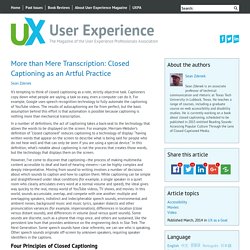
Captioners copy down what people are saying, a task so easy, even a computer can do it. For example, Google uses speech recognition technology to fully automate the captioning of YouTube videos. The results of autocaptioning are far from perfect, but the basic assumption behind this effort is that automation is possible because captioning is nothing more than mechanical transcription. Tactile Captions: Augmenting Visual Captions. Closed-Captioned Videos.
What needs closed-captioned?

If a deaf or hard of hearing (DHH) student approved for closed captioning accommodations is registered for your course, SAS will email you approximately six weeks before the semester starts. SAS will provide instructions on what materials require closed captions (e.g., YouTube links, DVDs, narrated PowerPoints, and VHS tapes) and how to submit them. The time frame of SAS’s communication with you can vary depending on when the student registers for classes. Due to the labor intensive process, SAS will include a specified due date for your materials to ensure adequate turnaround time.
Caption, translate, subtitle and transcribe video. 6 Tips For Closed Captioning eLearning Courses. Adding closed captioning to your eLearning course may be a good investment of both time and resources, but it also enables you to bring all of the benefits your eLearning courses offer to the deaf and/or hard of hearing learners. In this post I'll share some tips on how to add closed captioning to your eLearning courses. Closed captioning eLearning courses gives you the power to deliver effective and meaningful learning experiences to deaf and/or hard of hearing learners.
As such, you can provide them with the same skill set development and knowledge base expansion that other members of your learning audience receive, which will allow them to achieve their learning goals without being excluded. Caption It Yourself™ - Described and Captioned Media Program. Captions (sometimes called “subtitles”) are the textual representation of a video's soundtrack. They are critical for viewers who are deaf or hard of hearing, and they are also a great tool for improving the reading and listening skills of others. If you upload video to the Web, and that video includes sound, you should always include a text alternative, such as captions. As an added bonus, since most captioning for the Web relies on text, providing captions for your videos will ensure that they are indexed by search engines more quickly and accurately, meaning your video will reach more people.
What's in a Caption? A video's captions can transmit all of the following types of audible information: Narration Dialogue Sound Effects Other Information Move your mouse over the icons above and click the photos for examples. UDL On Campus: Captions. Best Practices The Described and Captioned Media Program (DCMP) states that quality captioning must be accurate, consistent, clear, readable, and equal. Captions assist viewers in the process of reading and support visual content by presenting text of spoken dialogue in a video. Captions are beneficial for new and struggling readers, learners of a new language, and people with hearing loss and speech processing difficulties. They also increase search engine optimization (SEO). Video Captioning Requirements, Best Practices, and Emerging Standards, Knowbility.
Best Practice: Captioning Video Content - Blackboard Help. Captions, Transcripts, and Audio Descriptions. Closed-Captioning-Resources-and-Best-Practices. Best practices in online captioning. Reasonable Accommodations Explained. 530901.pdf.